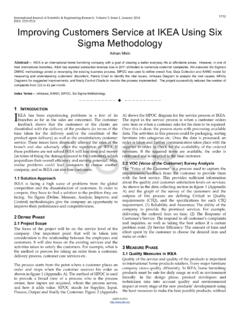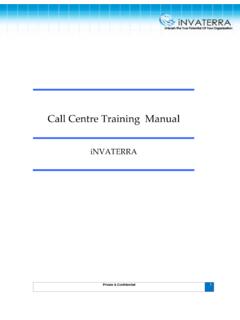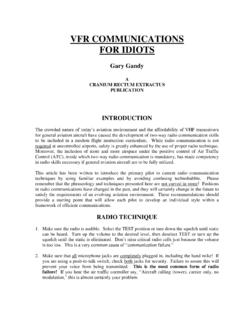Transcription of CompTIA Network+ Certification Exam Objectives
1 CompTIA Network+. Certification Exam Objectives EXAM NUMBER: N10-006. About the Exam Candidates are encouraged to use this document to help prepare for the CompTIA Network+ N10-006. exam. This exam will certify that the successful candidate has the knowledge and skills required to troubleshoot, configure and manage common network wireless and wired devices. Knowledge and skills include: Establishing basic network design and connectivity understanding and maintaining network documentation Identifying network limitations and weaknesses Implementing network security, standards and protocols The successful candidate will have a basic understanding of emerging technologies including unified communications, mobile, cloud and virtualization technologies. These content examples are meant to clarify the test Objectives and should not be construed as a comprehensive listing of all the content of this examination.
2 EXAM ACCREDITATION. The CompTIA Network+ exam is accredited by the American National Standards Institute (ANSI) to show compliance with the International Organization for Standardization (ISO) 17024. Standard and, as such, undergoes regular reviews and updates to the exam Objectives . EXAM DEVELOPMENT. CompTIA exams result from subject matter expert workshops and industry-wide survey results regarding the skills and knowledge required of an entry-level IT professional. CompTIA AUTHORIZED MATERIALS USE POLICY. CompTIA Certifications, LLC is not affiliated with and does not authorize, endorse or condone utilizing any content provided by unauthorized third-party training sites (aka brain dumps ). Individuals who utilize such materials in preparation for any CompTIA examination will have their certifications revoked and be suspended from future testing in accordance with the CompTIA Candidate Agreement.
3 In an effort to more clearly communicate CompTIA 's exam policies on use of unauthorized study materials, CompTIA directs all Certification candidates to the CompTIA Certification Exam Policies. Please review all CompTIA policies before beginning the study process for any CompTIA exam. Candidates will be required to abide by the CompTIA Candidate Agreement. If a candidate has a question as to whether study materials are considered unauthorized (aka brain dumps ), he/she should contact CompTIA at to confirm. PLEASE NOTE. The lists of examples provided in bulleted format are not exhaustive lists. Other examples of technologies, processes or tasks pertaining to each objective may also be included on the exam although not listed or covered in this Objectives document. CompTIA is constantly reviewing the content of our exams and updating test questions to be sure our exams are current and the security of the questions is protected.
4 When necessary, we will publish updated exams based on existing exam Objectives . Please know that all related exam preparation materials will still be valid. CompTIA Network+ Certification Exam Objectives Version (Exam Number: N10-006). TEST DETAILS. Required exam N10-006. JK0-023 (for CompTIA Academy Partners only). Number of questions Maximum of 90. Types of questions Multiple choice and performance-based Length of test 90 minutes Recommended experience CompTIA A+ Certified, or equivalent Minimum of 9 months of experience in network support or administration; or academic training Passing score 720 (on a scale of 100 900). EXAM Objectives (DOMAINS). The table below lists the domains measured by this examination and the extent to which they are represented: DOMAIN PERCENTAGE OF EXAMINATION. Network Architecture 22%. Network Operations 20%.
5 Network Security 18%. Troubleshooting 24%. Industrial Standards, Practices and Network Theory 16%. Total 100%. CompTIA Network+ Certification Exam Objectives Version (Exam Number: N10-006). Network Architecture Explain the functions and applications of various network devices. Router IDS/IPS Analog modem Switch Access point (wireless/wired) Packet shaper Multilayer switch Content filter VPN concentrator Firewall Load balancer HIDS Hub Compare and contrast the use of networking services and applications. VPN TACACS/RADIUS. - Site-to-site/host-to-site/host-to-host RAS. - Protocols Web services - IPSec Unified voice services - GRE Network controllers - SSL VPN. - PTP/PPTP. Install and configure the following networking services/applications. DHCP DNS NAT. - Static vs. dynamic IP addressing - DNS servers - PAT. - Reservations - DNS records (A, MX, AAAA, CNAME, PTR) - SNAT.
6 - Scopes - Dynamic DNS - DNAT. - Leases Proxy/reverse proxy Port forwarding - Options (DNS servers, suffixes). - IP helper/DHCP relay Explain the characteristics and benefits of various WAN technologies. Fiber PPP/multilink PPP Leased lines - SONET MPLS - T-1. - DWDM GSM/CDMA - T-3. - CWDM - LTE/4G - E-1. Frame relay - HSPA+ - E-3. Satellite - 3G - OC3. Broadband cable - Edge - OC12. DSL/ADSL Dialup Circuit switch vs. packet switch ISDN WiMAX. ATM MetroEthernet CompTIA Network+ Certification Exam Objectives Version (Exam Number: N10-006). Network Architecture Install and properly terminate various cable types and connectors using appropriate tools. Copper connectors - Straight-through vs. Tools - RJ-11 crossover vs. rollover - Cable crimpers - RJ-45 Fiber connectors - Punchdown tool - RJ-48C - ST - Wire strippers - DB-9/RS-232 - SC - Snips - DB-25 - LC - OTDR.
7 - UTP coupler - MTRJ - Cable certifier - BNC coupler - FC. - BNC - Fiber coupler - F-connector Fiber cables - 110 block - Single-mode - 66 block - Multimode Copper cables - APC vs. UPC. - Shielded vs. unshielded Media converters - CAT3, CAT5, CAT5e, CAT6, CAT6a - Single-mode fiber to Ethernet - PVC vs. plenum - Multimode fiber to Ethernet - RG-59 - Fiber to coaxial - RG-6 - Single-mode to multimode fiber Differentiate between common network topologies. Mesh Bus Point-to-point - Partial Ring Point-to-multipoint - Full Star Client-server Hybrid Peer-to-peer Differentiate between network infrastructure implementations. WAN SCADA/ICS. MAN - ICS server LAN - DCS/closed network WLAN - Remote terminal unit - Hotspot - Programmable logic controller PAN Medianets - Bluetooth - VTC. - IR - ISDN. - NFC - IP/SIP. CompTIA Network+ Certification Exam Objectives Version (Exam Number: N10-006).
8 Network Architecture Given a scenario, implement and configure the appropriate addressing schema. IPv6 - Tunneling 6to4, 4to6. - Auto-configuration - Teredo, miredo Private vs. public - EUI 64 IPv4 NAT/PAT. - DHCP6 - Address structure MAC addressing - Link local - Subnetting Multicast - Address structure - APIPA Unicast - Address compression - Classful A, B, C, D Broadcast - Classless Broadcast domains vs. collision domains Explain the basics of routing concepts and protocols. Loopback interface Link state routing protocols Route aggregation Routing loops - OSPF Routing metrics Routing tables - IS-IS - Hop counts Static vs. dynamic routes Interior vs. exterior gateway - MTU, bandwidth Default route routing protocols - Costs Distance vector routing protocols Autonomous system numbers - Latency - RIPv2 Route redistribution - Administrative distance Hybrid routing protocols High availability - SPB.
9 - BGP - VRRP. - Virtual IP. - HSRP. Identify the basics elements of unified communication technologies. VoIP QoS Devices Video - DSCP - UC servers Real-time services - COS - UC devices - Presence - UC gateways - Multicast vs. unicast CompTIA Network+ Certification Exam Objectives Version (Exam Number: N10-006). Network Architecture Compare and contrast technologies that support cloud and virtualization. Virtualization Storage area network Cloud concepts - Virtual switches - iSCSI - Public IaaS, SaaS, PaaS. - Virtual routers - Jumbo frame - Private IaaS, SaaS, PaaS. - Virtual firewall - Fibre Channel - Hybrid IaaS, SaaS, PaaS. - Virtual vs. physical NICs - Network attached storage - Community IaaS, SaaS, PaaS. - Software-defined networking Given a set of requirements, implement a basic network. List of requirements Device types/requirements Environment limitations Equipment limitations Compatibility requirements Wired/wireless considerations Security considerations CompTIA Network+ Certification Exam Objectives Version (Exam Number: N10-006).
10 Network Operations Given a scenario, use appropriate monitoring tools. Packet/network analyzer Alerts Power monitoring tools Interface monitoring tools - Email Wireless survey tools Port scanner - SMS Wireless analyzers Top talkers/listeners Packet flow monitoring SNMP management software SYSLOG. - Trap SIEM. - Get Environmental monitoring tools - Walk - Temperature - MIBS - Humidity Given a scenario, analyze metrics and reports from monitoring and tracking performance tools. Baseline - Network device CPU - Discards Bottleneck - Network device memory - Packet drops Log management - Wireless channel utilization - Interface resets Graphing Link status - Speed and duplex Utilization Interface monitoring - Bandwidth - Errors - Storage - Utilization Given a scenario, use appropriate resources to support configuration management. Archives/backups NAC - IP address utilization Baselines Documentation - Vendor documentation On-boarding and off-boarding - Network diagrams (logical/physical) - Internal operating procedures/.







